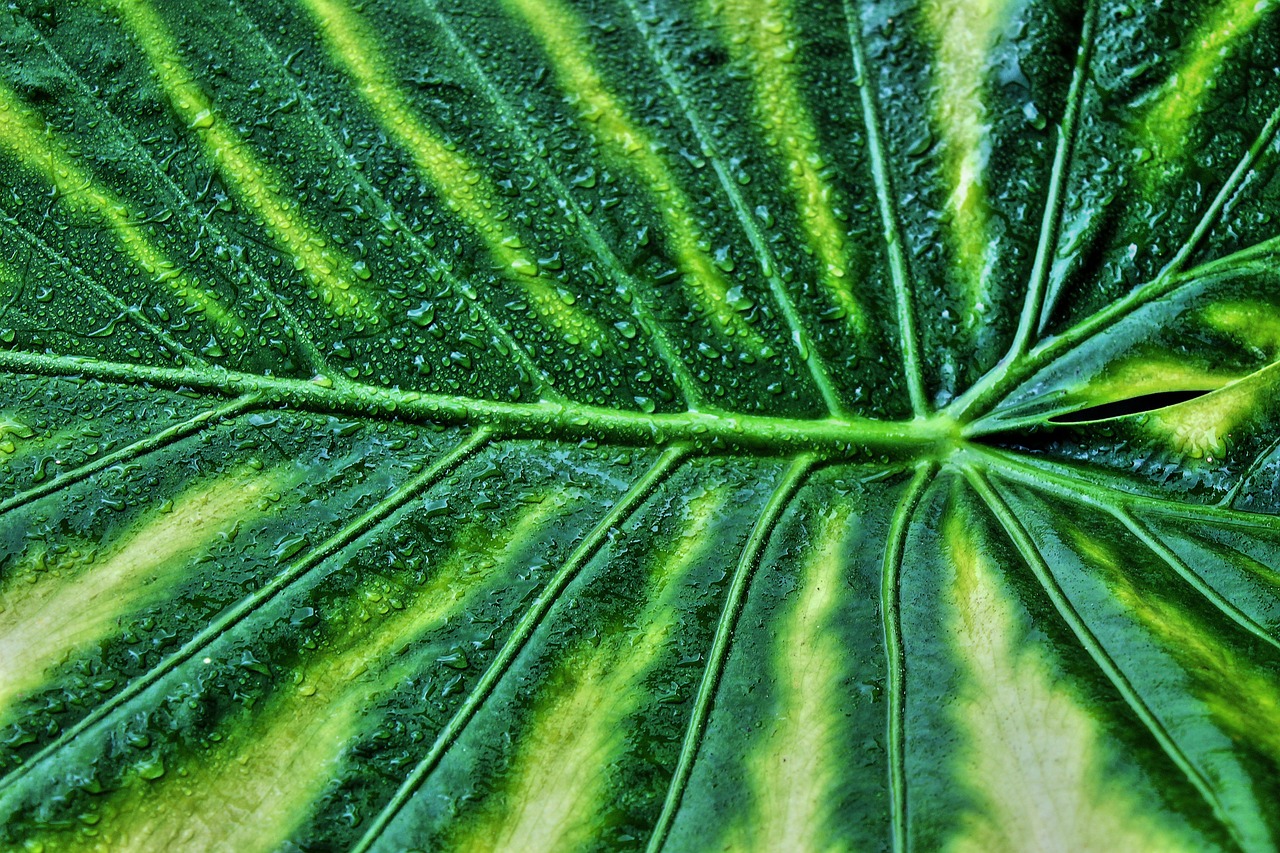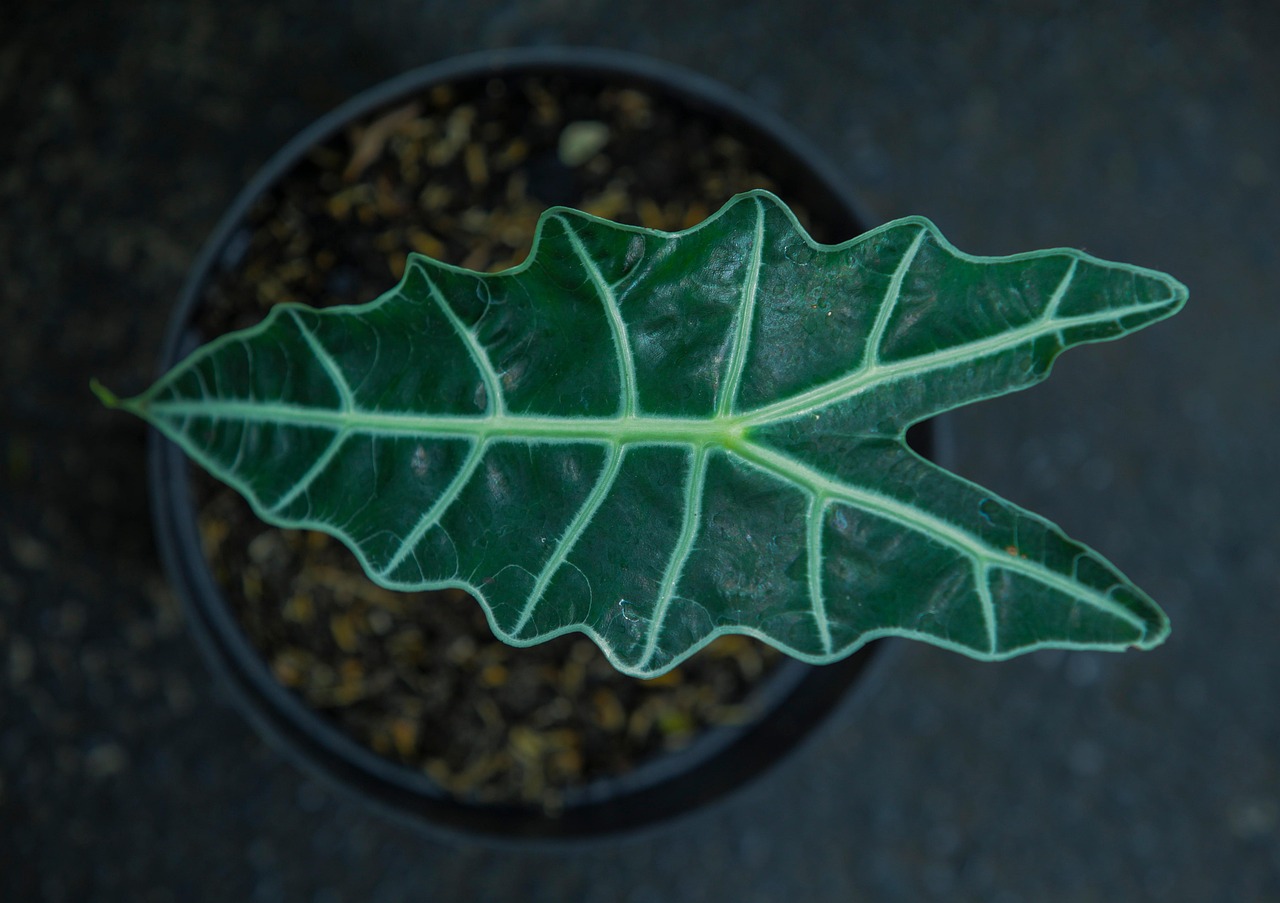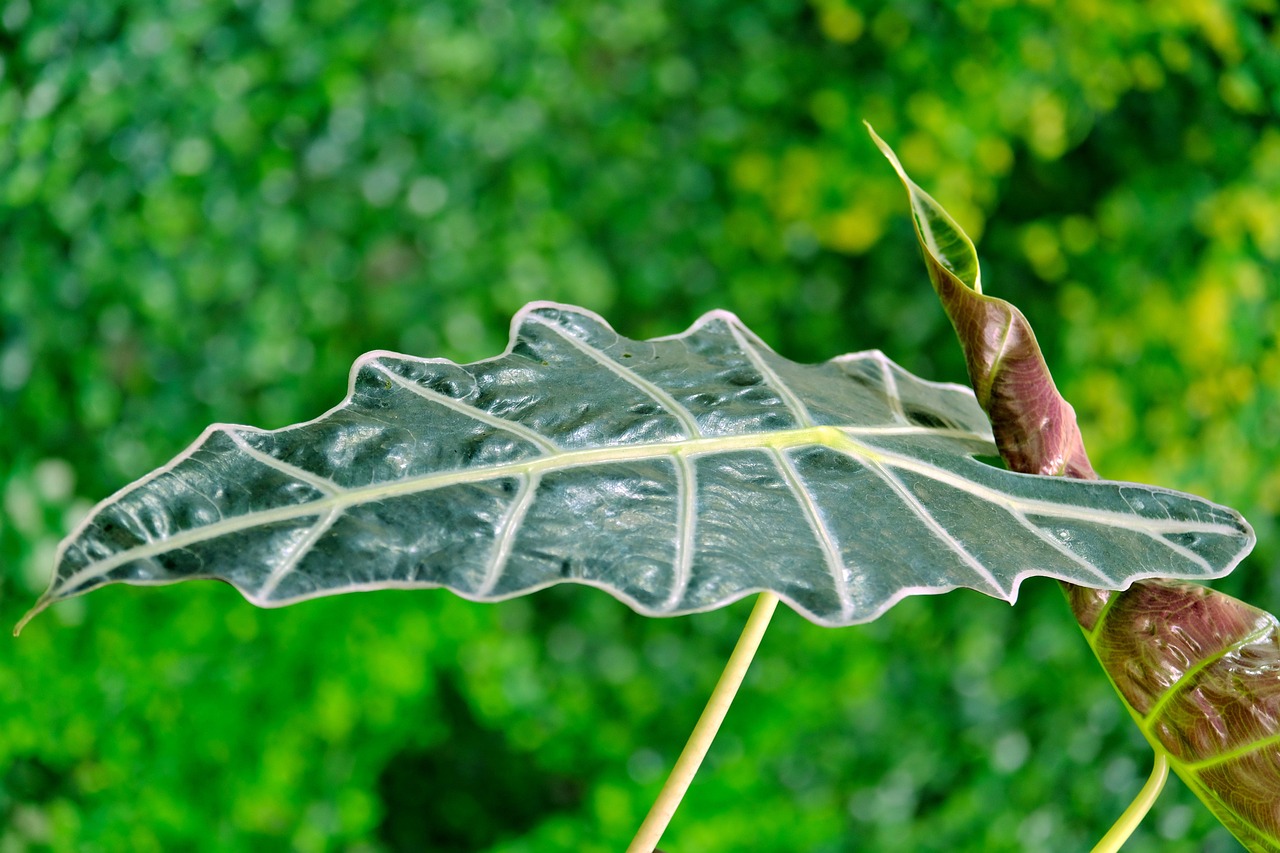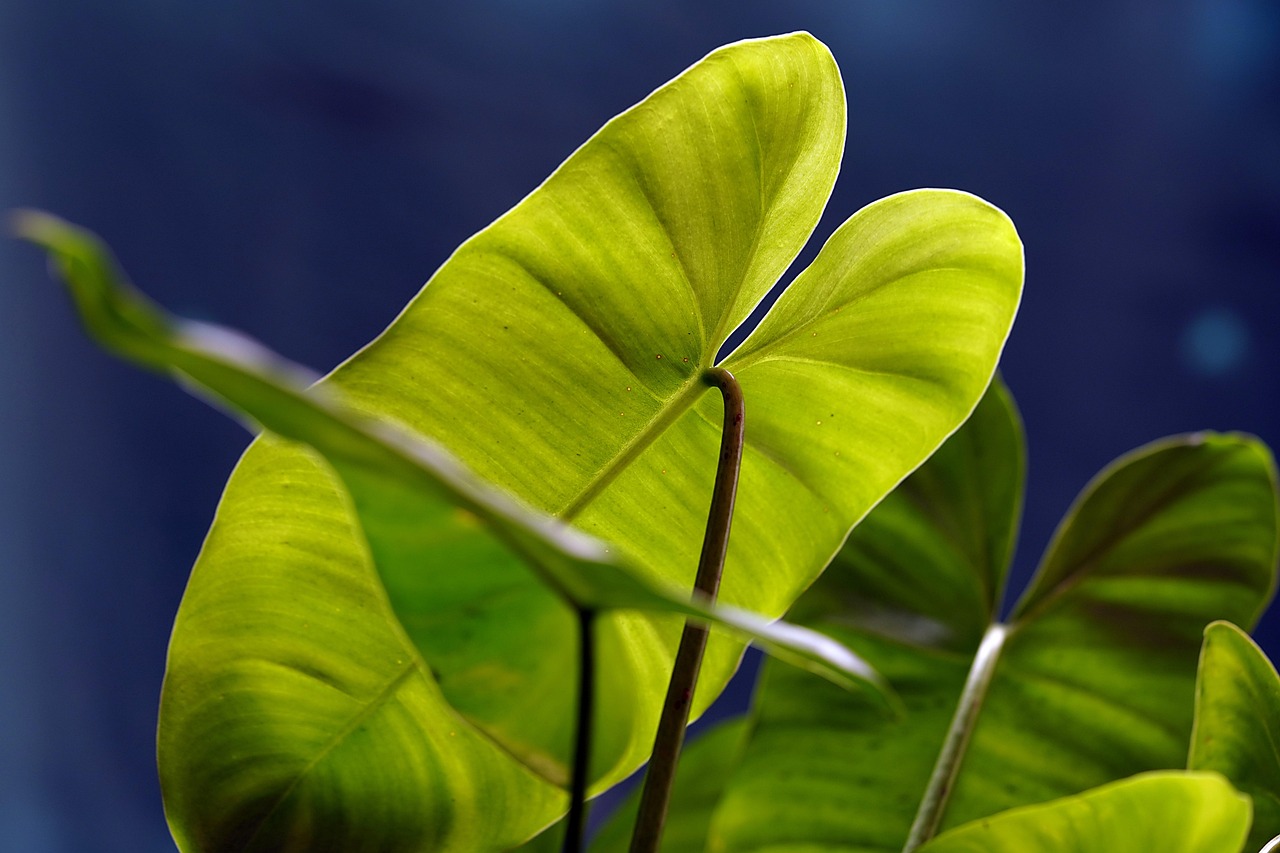The Chantrieri Alocasia is a rare and exquisite plant that requires specific care to thrive. Collectors should focus on providing optimal humidity, indirect light, and well-draining soil to ensure healthy growth and vibrant foliage.
Understanding the Chantrieri Alocasia

The Chantrieri Alocasia, often referred to as the Black Dragon, is a stunning tropical plant native to Southeast Asia. This particular species is cherished by collectors for its unique, dramatic leaves that feature deep green coloration with striking veins. The leaves can grow quite large, making them a focal point in any indoor garden or plant collection.
As a member of the Araceae family, the Chantrieri Alocasia is part of a group of plants known for their stunning foliage and unique growth habits. These plants can reach impressive heights of up to three feet or more when cared for properly, making them an eye-catching addition to any space. However, their beauty comes with specific care requirements that must be met to maintain their health.
In this guide, we will explore the essential aspects of caring for the Chantrieri Alocasia. From understanding its environmental needs to recognizing potential pests, collectors will gain valuable insights into how to nurture this rare plant successfully.
Essential Care Requirements
To ensure your Chantrieri Alocasia thrives, it is crucial to provide the right environment and care. Below are some key factors to consider:
- Light: The Chantrieri Alocasia prefers bright, indirect light. Direct sunlight can scorch the leaves, while too little light may hinder growth.
- Humidity: High humidity levels around 60-80% are ideal for this plant. Consider using a humidifier or misting the leaves regularly.
- Soil: A well-draining potting mix is essential. A combination of potting soil, perlite, and orchid bark works well.
- Watering: Keep the soil consistently moist but not soggy. Allow the top inch of soil to dry out between waterings.
- Temperature: Maintain temperatures between 65°F and 85°F (18°C to 29°C). Avoid cold drafts and sudden temperature changes.
Nutritional Needs
Feeding your Chantrieri Alocasia is an important aspect of its care. During the growing season, typically from spring to early fall, it benefits from regular fertilization. Use a balanced fertilizer diluted to half strength every four to six weeks. This practice promotes healthy growth and vibrant foliage.
Pest Management
While the Chantrieri Alocasia is relatively resilient, it can be susceptible to certain pests. Common pests include spider mites, aphids, and mealybugs. Regularly inspecting your plant for signs of infestation is essential. If you notice any pests, consider the following management strategies:
- Isolation: Quarantine affected plants to prevent pests from spreading to healthy ones.
- Insecticidal Soap: Use insecticidal soap or neem oil as a natural treatment for infestations.
- Regular Cleaning: Wipe leaves with a damp cloth to remove dust and potential pest eggs.
Propagation Techniques
For collectors interested in propagating their Chantrieri Alocasia, there are a few methods available. The most common method is through division. This technique involves separating the plant into smaller sections during repotting. Each section should have a healthy root system and at least one leaf for successful growth.
Another propagation method includes offsets, which are small bulbs that develop around the base of the plant. These can be carefully removed and planted in their pots to grow into new plants.
Choosing the Right Container
Selecting an appropriate container is essential for your Chantrieri Alocasia’s health. A pot with drainage holes is crucial to prevent waterlogging, which can lead to root rot. Clay pots are often recommended as they allow for better air circulation to the roots compared to plastic pots.
As your plant grows, consider repotting every couple of years or when you notice that it has outgrown its container. This practice helps refresh the soil and provides more room for root development.
Common Challenges and Solutions
Caring for the Chantrieri Alocasia can be rewarding, but it also comes with its own set of challenges. Understanding these potential issues can help collectors take proactive measures to ensure their plants thrive. Below are some common challenges faced by Chantrieri Alocasia owners, along with effective solutions.
Leaf Yellowing
One of the most common issues with the Chantrieri Alocasia is leaf yellowing. This condition can occur due to several reasons, including improper watering, lack of nutrients, or insufficient light. Here are some tips to address this issue:
- Check Watering Practices: Ensure that you are not overwatering or underwatering your plant. The soil should feel moist but not soggy.
- Adjust Light Conditions: If the plant is receiving too much direct sunlight, consider moving it to a location with bright, indirect light.
- Fertilization: Incorporate a balanced fertilizer during the growing season to provide essential nutrients.
Root Rot
Root rot is another concern for the Chantrieri Alocasia. This condition typically arises from excessive moisture in the soil. Here are steps to prevent and treat root rot:
- Ensure Proper Drainage: Use pots with drainage holes and a well-draining soil mix.
- Monitor Watering Schedule: Allow the top inch of the soil to dry out before watering again.
- Inspect Roots: If you suspect root rot, gently remove the plant from its pot and inspect the roots. Trim away any black or mushy roots and repot in fresh soil.
Environmental Considerations
The Chantrieri Alocasia thrives in specific environmental conditions. Ensuring that these conditions are met can significantly enhance the plant’s health and growth.
Humidity Levels
High humidity is crucial for the Chantrieri Alocasia, as it mimics its natural tropical habitat. Here are some ways to increase humidity:
- Use a Humidifier: Placing a humidifier near your plant can help maintain optimal humidity levels.
- Misting: Regularly mist the leaves with water, especially during dry seasons.
- Group Plants Together: Placing your Chantrieri Alocasia with other plants can create a microclimate with increased humidity.
Temperature Requirements
This plant prefers warmer temperatures between 65°F and 85°F (18°C to 29°C). Sudden temperature fluctuations can stress the plant and lead to issues such as leaf drop. Here are some tips for maintaining appropriate temperatures:
- Avoid Drafts: Keep your plant away from windows or doors that experience cold drafts.
- Monitor Temperature Changes: Use a thermometer to ensure that the environment remains stable.
- Select Appropriate Locations: Place your Chantrieri Alocasia in a warm room or near a heat source that doesn’t dry out the air.
Pest Identification and Prevention
Pests can pose a significant risk to the Chantrieri Alocasia. Early detection is key to managing infestations effectively. Below are common pests that may affect your plant along with identification tips and prevention strategies.
Common Pests
| Pest | Identification | Prevention |
|---|---|---|
| Spider Mites | Fine webbing on leaves and small yellow spots. | Maintain high humidity and regularly check for webs. |
| Mealybugs | White cottony masses on leaves and stems. | Use neem oil as a preventative treatment. |
| Aphids | Small green or black insects on new growth. | Encourage beneficial insects like ladybugs. |
Regular inspections of your Chantrieri Alocasia can help you catch any pest issues early. Look closely at the undersides of leaves, where pests often hide. If you notice any signs of pests, act quickly to remove them before they multiply.
Seas

onal Care Adjustments
Caring for your
Seasonal Care Adjustments
As the seasons change, so do the care requirements for the Chantrieri Alocasia. Understanding how to adjust your care routine throughout the year will help ensure that your plant remains healthy and vibrant. Each season presents unique challenges and opportunities for growth.
Spring Care
Spring marks the beginning of the growing season for the Chantrieri Alocasia. During this time, you may notice new growth emerging. Here are some important care tips for spring:
- Increase Watering: As temperatures rise and days lengthen, your plant will require more water. Monitor the soil moisture and increase watering frequency as needed.
- Fertilization: Begin fertilizing with a balanced liquid fertilizer every four to six weeks. This provides nutrients essential for growth.
- Repotting: If your plant has outgrown its container, spring is an ideal time to repot. Choose a slightly larger pot and refresh the soil to encourage new growth.
Summer Care
Summer brings warmth and increased light levels, which can benefit the Chantrieri Alocasia. However, it also requires careful management to prevent stress:
- Maintain Humidity: The warm air can dry out quickly. Consider using a humidifier or placing a pebble tray filled with water beneath the pot to maintain humidity levels.
- Monitor for Pests: Keep an eye out for common pests during the summer months. Regularly inspect the leaves and treat any infestations promptly.
- Avoid Direct Sunlight: While bright light is beneficial, avoid exposing your plant to harsh, direct sunlight, which can scorch the leaves.
Fall Care
As fall approaches, the Chantrieri Alocasia begins to enter a period of dormancy. Adjusting care is essential during this transitional phase:
- Reduce Watering: With cooler temperatures, your plant will require less water. Allow the top few inches of soil to dry out before watering again.
- Lessen Fertilization: Cut back on fertilizing as growth slows down. Fertilizing less frequently can help prevent nutrient buildup in the soil.
- Check for Pests: Continue to monitor for pests as indoor conditions may become more favorable for infestations during cooler months.
Winter Care
Winter can be challenging for tropical plants like the Chantrieri Alocasia. Indoor environments often become dry due to heating systems. Here are key care tips for winter:
- Maintain Adequate Humidity: Use a humidifier to keep humidity levels above 60%. Misting can help but may not be enough in dry indoor conditions.
- Avoid Cold Drafts: Ensure your plant is placed away from windows and doors where cold drafts can cause stress.
- Limit Watering: Reduce watering frequency as the plant’s growth slows down. Be cautious of overwatering during this time.
Signs of Stress and How to Respond
Recognizing signs of stress in your Chantrieri Alocasia can help you address problems before they become severe. Some common stress indicators include:
- Wilting Leaves: This can indicate underwatering or overwatering. Assess your watering practices immediately.
- Leaf Drop: If leaves are falling off, it may be due to sudden temperature changes or inadequate humidity. Check the environment and adjust accordingly.
- Browning Leaf Edges: This is often a sign of low humidity or extreme temperatures. Increase humidity levels and ensure stable temperatures.
If you notice any of these signs, take swift action to correct the underlying issues. Adjusting your care routine promptly can help your plant recover and thrive once more.
Cultivating a Thriving Environment
Culti

vating a thriving environment for your Chantrieri Alocasia requires ongoing attention to detail. Here are some additional tips to enhance its living conditions:
- Rotate Your Plant: Regularly rotate your plant to ensure even light exposure on all sides, promoting balanced growth.
- Create a Plant Care Schedule: Maintaining a consistent schedule for watering, fertilizing, and inspecting your plant can help you stay on top of its needs.
- Use Proper Tools: Invest in quality tools such as moisture meters, pruners, and pots with drainage holes to facilitate effective care.
Your commitment to understanding and responding to the needs of your Chantrieri Alocasia will significantly impact its health and aesthetic appeal. By staying vigilant and adjusting care according to seasonal changes, you can enjoy this rare beauty in your collection for years to come.
Advanced Techniques for Chantrieri Alocasia Care
For dedicated collectors looking to elevate their Chantrieri Alocasia care, there are advanced techniques that can enhance the growth and overall health of the plant. These methods may require additional effort but can lead to remarkable results.
Soil Amendments
Improving your soil mix can significantly impact the growth of your Chantrieri Alocasia. Consider the following amendments:
- Coconut Coir: This natural fiber helps retain moisture while providing excellent aeration. It can be mixed with standard potting soil for improved drainage.
- Perlite: Adding perlite to your soil mix increases aeration and drainage, which is crucial for preventing root rot.
- Worm Castings: Incorporating worm castings into the soil can provide a slow-release source of nutrients, enhancing soil fertility.
Temperature and Light Optimization
In addition to monitoring humidity and watering, optimizing temperature and light conditions can enhance your plant’s performance:
- Supplemental Lighting: During shorter days in the fall and winter, consider using grow lights to supplement natural light. This can help maintain growth during the dormant season.
- Heat Mats: If you live in a cooler climate, using a heat mat can help maintain optimal root temperatures, especially in winter when indoor temperatures drop.
Foliage Care
Maintaining the health of the leaves is essential for overall plant vitality:
- Regular Dusting: Dust accumulation can hinder photosynthesis. Use a damp cloth to gently wipe the leaves and keep them clean.
- Leaf Pruning: Remove any yellowing or damaged leaves to promote new growth and improve air circulation around the plant.
- Foliage Sprays: Occasionally spraying the leaves with a diluted liquid fertilizer can provide extra nutrients directly through the foliage.
Expected Growth Patterns
The Cha

ntrieri Alocasia is known for its striking growth patterns. Understanding these can help you set realistic expectations for your plant:
- Growth Rate: This species typically grows at a moderate pace. In optimal conditions, you may see new leaves every few weeks during the growing season.
- Leaf Size: As the plant matures, expect larger leaves. If your plant is not producing larger foliage, it may be time to check its care regimen.
- Corm Development: The Chantrieri Alocasia develops corms, which are underground storage organs. These can be propagated and will produce new plants when conditions are right.
Final Thoughts
Caring for the Chantrieri Alocasia requires dedication and attention but rewards collectors with its unique foliage and beauty. By understanding its specific needs—such as humidity, light, and soil composition—plant enthusiasts can create an ideal environment for this rare species.
By implementing seasonal adjustments and advanced care techniques, you can foster a thriving Chantrieri Alocasia that not only enhances your collection but also brings joy to your living space. Remember to stay observant of any changes in your plant’s health and be proactive in addressing potential issues.
The journey of growing a Chantrieri Alocasia can be incredibly fulfilling. With patience and knowledge, collectors can successfully cultivate this stunning tropical gem, ensuring it flourishes for many years. Enjoy the process of nurturing your plant, and let its beauty inspire you as it grows.
